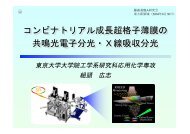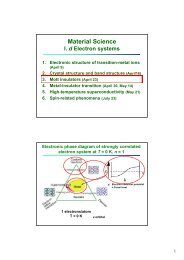Thesis High-Resolution Photoemission Study of Kondo Insulators ...
Thesis High-Resolution Photoemission Study of Kondo Insulators ...
Thesis High-Resolution Photoemission Study of Kondo Insulators ...
Create successful ePaper yourself
Turn your PDF publications into a flip-book with our unique Google optimized e-Paper software.
8 Chapter 1. Introduction<br />
only the narrow gap at low temperature, but also the temperature dependence <strong>of</strong> the<br />
magnetic susceptibility is reminiscent <strong>of</strong> the 4f <strong>Kondo</strong> insulator [1.1] although FeSi has<br />
no f electrons. <strong>Photoemission</strong> spectra <strong>of</strong> FeSi may therefore resemble those <strong>of</strong> YbB12<br />
in some respects but may not in others. The similarities and differences between YbB12<br />
and FeSi would give an important information on the physics <strong>of</strong> these compounds,<br />
including the contribution <strong>of</strong> single-site and intersite interactions.<br />
1.2 YbB12 and FeSi<br />
The semiconducting behavior <strong>of</strong> YbB12 was first reported by Kasaya et al. [1.4]. Its<br />
properties have <strong>of</strong>ten been discussed together with another rare-earth-boride semicon-<br />
ductor SmB6, but the simplicity <strong>of</strong> the 4f-level occupancy for Yb (4f 13 and 4f 14 ), which<br />
is the same as that for Ce (4f 1 and 4f 0 ) considering the electron-hole symmetry, is a<br />
remarkable advantage <strong>of</strong> studying YbB12. An Yb atom in YbB12 is almost a <strong>Kondo</strong> ion<br />
(Yb 3+ ) while a Sm atom in SmB6 has an intermediate-valent character (Sm 2.6+ ). RB12<br />
(R = late rare-earth element) forms a NaCl-type cubic structure which consists <strong>of</strong> the<br />
rare-earth element and the B12 polyhedron (UB12 structure) as shown in Fig 1.6. In the<br />
B12 polyhedron, 38 electrons fill the bonding orbitals [1.10]. Since three electrons (2s2 ,<br />
2p1 ) per B atom contribute to the bonding, B12 becomes closed-shell for the divalent<br />
anion (B 2−<br />
12 ). Thus if R is a divalent cation, RB12 would be an insulator or a semimetal.<br />
The magnetic susceptibility <strong>of</strong> YbB12 is shown in Fig. 1.7. It follows the Curie-<br />
Weiss law above ∼ 170 K and Iga et al. has estimated the Yb valence to be ∼ 2.85<br />
from the Curie constant [1.12]. On cooling, it decreases rapidly after showing a broad<br />
maximum around 75 K. Since the bonding orbitals <strong>of</strong> the B12 polyhedron are filled by<br />
two electrons per Yb atom, nearly one electron per Yb atom is expected to contribute<br />
to the conductivity. However, the electrical resistivity <strong>of</strong> YbB12 rises sharply below 50<br />
K with the activation energy <strong>of</strong> 6 meV [1.13]. Lu (4f 14 ) compounds are <strong>of</strong>ten good<br />
references for Yb compounds just like La (4f 0 ) compounds for Ce compounds. LuB12,<br />
as well as alloy system Yb1−xLuxB12, has been studied as a reference <strong>of</strong> YbB12 [1.14].<br />
In LuB12, the Lu 4f level, which forms the closed-shell 4f 14 configuration, is located ∼<br />
8 eV below EF [1.15].<br />
On the other hand, the study <strong>of</strong> FeSi has a long history <strong>of</strong> more than a half century.<br />
FeSi forms a B20-type cubic structure as shown in Fig. 1.8. The B20-type structure<br />
is a modified NaCl structure, where both Fe and Si atoms are shifted along the (111)






